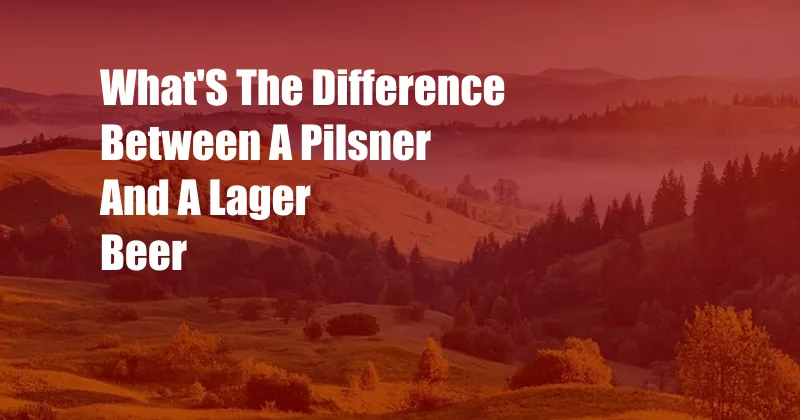
**Beer Basics: Deciphering the Difference Between Pilsners and Lagers**
In the realm of beer, the terms “pilsner” and “lager” are often used interchangeably. While both belong to the lager family, they possess subtle yet distinct characteristics that can elevate your tasting experience. Embark on this beer-filled adventure as we delve into the nuances that differentiate these two popular brews.
Unveiling Pilsners: The Golden Standard
Pilsners, renowned for their crisp and refreshing taste, originated in the Czech city of Plzeň. Brewed using bottom-fermenting yeast at cooler temperatures, they undergo a longer lagering period, resulting in a beer with a brilliant golden hue and a pronounced hop aroma. The hallmark of a pilsner lies in its delicate balance between bitterness and maltiness, making it a favorite among beer enthusiasts worldwide.
**Lagers: The Lagered Lineage**
Lagers, a more comprehensive category, encompass a wide range of beers characterized by their clean, crisp flavors and bottom-fermentation process. Originating in Germany, they are typically brewed at colder temperatures than ales, resulting in a smoother, less fruity profile. Lagers exhibit a vast spectrum of styles, from the light and sessionable Helles to the robust and full-flavored Doppelbock, catering to diverse palates.
**The Telltale Traits: Unveiling the Similarities and Distinctions**
Both pilsners and lagers share the common traits of being bottom-fermented and lagered. However, the devil lies in the details. Pilsners, with their Czech heritage, are defined by their use of noble hops, such as Saaz and Hallertau, which impart a distinctive floral and spicy aroma. Lagers, on the other hand, offer a broader range of hop varieties, allowing for a more diverse flavor profile.
In terms of taste, pilsners are renowned for their crisp, refreshing bitterness, while lagers tend to be smoother and less hoppy. Pilsners exhibit a delicate balance between bitterness and maltiness, while lagers showcase a wider spectrum of flavors, from the light and refreshing to the robust and malty.
**The Latest Buzz: Innovations in the Pilsner and Lager World**
The world of beer is constantly evolving, and pilsners and lagers are no exception. Craft breweries are experimenting with innovative twists on these classic styles. Some brewers are incorporating new hop varieties into their pilsners, resulting in beers with unique and exciting flavor profiles. Others are experimenting with different fermentation methods, such as using top-fermenting yeast, to create hybrid styles that blur the lines between pilsners and ales.
The lager category is also seeing its share of innovation. Some brewers are creating “craft lagers” that combine the clean, crisp flavors of traditional lagers with the bold and flavorful hops of craft beers. Others are exploring the use of adjunct ingredients, such as fruits and spices, to create unique and refreshing lager styles.
**Pro Tips for Enhancing Your Pilsner and Lager Experience**
- Serve chilled: Pilsners and lagers are best enjoyed when served chilled, between 45°F and 55°F.
- Use the right glassware: A pilsner glass, with its tall and narrow shape, helps to enhance the beer’s aroma and flavor.
- Pair with food: Pilsners and lagers pair well with a variety of foods, including grilled meats, fish, and salads.
**FAQs on Pilsners and Lagers**
Q: Are pilsners and lagers the same?
A: Pilsners are a type of lager, but not all lagers are pilsners. Pilsners have a more defined flavor profile, with a crisp bitterness and a pronounced hop aroma.
Q: What are the different types of lagers?
A: There are many different types of lagers, including Helles, Dunkel, Bock, and Pilsner. Each type has its own unique flavor profile and characteristics.
Q: How are pilsners and lagers made?
A: Pilsners and lagers are both bottom-fermented beers, which means that the yeast ferments at the bottom of the fermentation vessel. They are also lagered, which means that they are aged for a period of time at cold temperatures.
**Conclusion**
Whether you prefer the crisp bitterness of a pilsner or the smooth, refreshing taste of a lager, there is a beer out there to suit every palate. By understanding the differences between these two popular styles, you can embark on a beer-filled adventure that will take your taste buds on an unforgettable journey. So, next time you’re at a bar or beer festival, don’t hesitate to ask for a pilsner or lager, and discover the subtle yet distinct characteristics that make these beers truly special.
Are you a pilsner enthusiast or a lager loyalist? Share your thoughts and experiences in the comments below!